What Is the Blockchain Trilemma?

The inauguration of blockchain has set the foundation for an advanced ecosystem where users can transact and create assets over the decentralised network. Blockchain technology promotes three primary concepts, decentralisation, security, and scalability, that drive today’s advancements in the crypto space. This innovative technology enabled us to explore various capabilities to transact, operate, create, and monetise monetarily over the blockchain. However, it is challenging to optimise all blockchain’s abilities at the same time.
Blockchain technology faces a paradox that inhibits it from reaching its full potential. Let’s find out what this blockchain challenge is and if we can overcome it.
Key Takeaways
- Security, decentralisation, and scalability are three vital concepts in developing the blockchain and are the driving force behind Web 3.0 developments.
- The blockchain trilemma refers to optimising the three elements simultaneously and at the same level. However, the current nature of the blockchain implies enhancing one at the expense of another.
- A few introductions and updates seek solutions for this trilemma, including sharding, side chains, and adding a layer-2 blockchain network to improve performance and scalability.
- Ethereum 2.0 is the new update for the Ethereum blockchain that introduces a new consensus mechanism and adds layer 2 to try to solve this problem.
Bitcoin’s all-time high transaction fee is $70, while the all-time low was recorded in 2020 at $1.00.
Blockchain Trilemma Explained
The blockchain promotes the idea that applications and transactions can happen without waiting for a third party to approve them. It eliminates the need for a central entity that stores private and confidential information.
This idea requires the blockchain platforms to optimise security, decentralisation, and scalability. However, today’s challenge is to optimise all three classes at high levels and, at the same time, which Ethereum’s co-founder Vitalik Buterin named “Blockchain Trilemma”.
Going by the trilemma definition, it is a situation where someone needs to decide given three alternatives. In this case, the challenge is optimising decentralisation, scalability, and security at the same level.
This is a trilemma because developing one aspect comes at the expense of another factor. For example, increasing the blockchain’s scalability may lead to security compromise, which is conceptually against the basics of the blockchain.
In its latest update, Ethereum 2.0 claimed it would solve this paradox. However, this new iteration is still in its phased introduction, and it is unknown when and how it will solve it.
Let’s dive deeper into the three elements of the trilemma, what each means for the blockchain, and how it contributes to it.
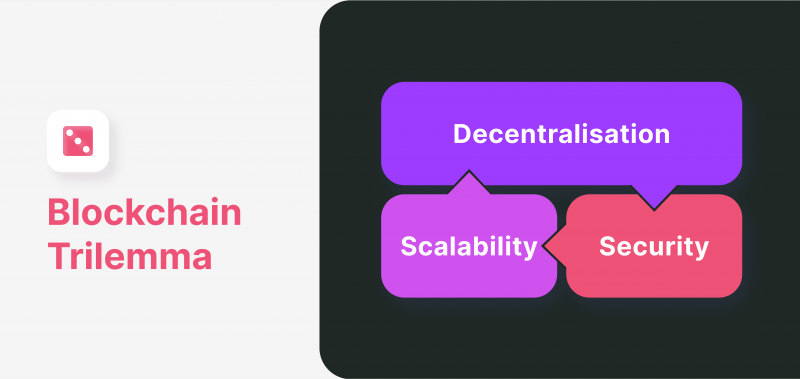
Scalability
A scalable blockchain performs efficiently during network peak times and can be used across multiple blockchain protocol systems to support various use cases.
Scalability is a vital blockchain feature that allows it to work with several blockchain networks and gives developers the opportunity to create and operate digital assets, financial applications, and decentralised apps.
Highly scalable blockchains allow developers to launch their dApps on multiple decentralised platforms without compromising functionality or usability.
However, scalability is a critical issue for the blockchain today regarding handling transaction throughput, given the number of validating nodes and active users.
Some blockchains can process 4,000 and 6,000 transactions per second. However, this is most likely when several nodes are available for only 50,000 online users. The question here is, will the blockchain be able to maintain similar transactions-per-second figures when serving millions?
Comparing the Bitcoin network to conventional social media platforms, Facebook and Twitter host way more monthly users than the active wallets in the BTC blockchain.
The BTC blockchain hosted 22 million active wallets in 2021, while Facebook had almost 3 billion active users in the same year. This means that blockchain networks have a long way to go and maintain high performance.
Decentralisation
Decentralisation is the principal notion of Web 3.0, driving much of today’s updates in the blockchain, cryptocurrencies, and applications. Decentralised networks entail that no central authority manages or controls the structure, but authority is shared among users, and control is distributed.
Have a Question About Your Brokerage Setup?
Our team is here to guide you — whether you're starting out or expanding.
Let’s take a look back at how a decentralised network works. It is a permissionless structure that allows transactions based on set rules without centralised systems.
Miners play a vital role in this network, and miners are computing machines that solve complex equations to confirm transactions in the blockchain. In exchange, miners or validating nodes earn transaction fees or, in some cases, tokens as a reward system.
Thus, nodes enjoy equal powers by the tokens and their contribution to the network, which is a great way to distribute the network equally in the decentralised world. No one in the decentralised network can make decisions independently. Instead, decisions are voted upon to reach a consensus.
However, if a blockchain wants to increase scalability, the consensus mechanism can take time to earn everyone’s vote. Therefore, it leads to more network processing time and congestion.
Additionally, there is a security concern because malicious entities can participate in the validation process and drive decisions to their benefit.
Security
Security is a significant concern and a central aspect of decentralised networks. Millions of transactions happen daily on the blockchain, and without a sophisticated security system, hackers will easily infiltrate and dry out the wallets from all its holdings. Main blockchain networks like Ethereum and Bitcoin usually have a better network security structure than newly emerging networks. Therefore, it is pretty difficult to breach their blockchain.
The main reason why hackers have targeted blockchains is because they are open-source, and anyone can read hashcodes and track transactions.
Blockchain security seems to work in opposition to other elements: decentralisation and scalability. When a blockchain is highly scalable, working with multiple networks and platforms, security is concerned with keeping the system consistent without further interferences.
Additionally, decentralisation implies that control lies among validating nodes, where only nodes can make decisions on transactions and other aspects. However, this may lead to security problems if malicious nodes participate in the vote and act according to their agenda.
Therefore, it is essential not to compromise security and focus on developing blockchain scalability and decentralisation with consideration to the security concerns. Otherwise, the whole blockchain ecosystem may collapse.
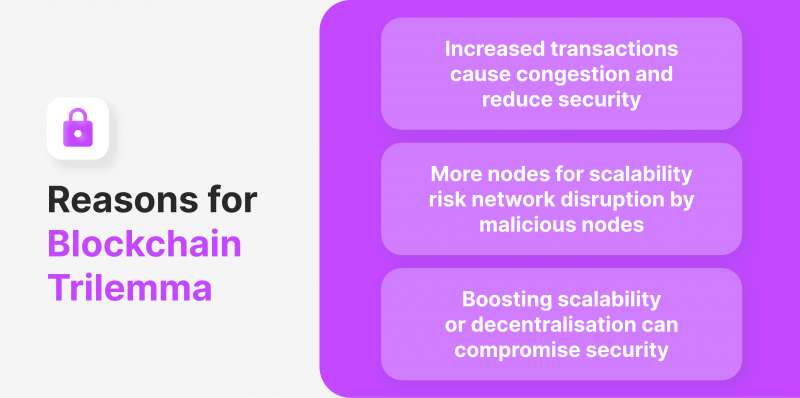
Why Does The Blockchain Trilemma Happen?
Most of the efforts today to develop the blockchain focus on scalability, which makes such networks usable for many users across multiple chains and networks while maintaining consistency.
However, the blockchain networks cannot handle a massive increase in transactions per second and may lead to huge congestion, destabilising the blockchain and weakening its security.
Additionally, a more scalable blockchain means more validating nodes to respond to the increasing transaction requests. However, this must ensure that all nodes are secure because one malicious node can disturb the whole network and trigger wrong orders.
Security is so fundamental for the blockchain that it cannot be compromised, and an increase in scalability or decentralisation can lead to security breaches.
Therefore, the challenge is reaching an optimum point among three elements because increasing one element will most likely come at the expense of decreasing another.
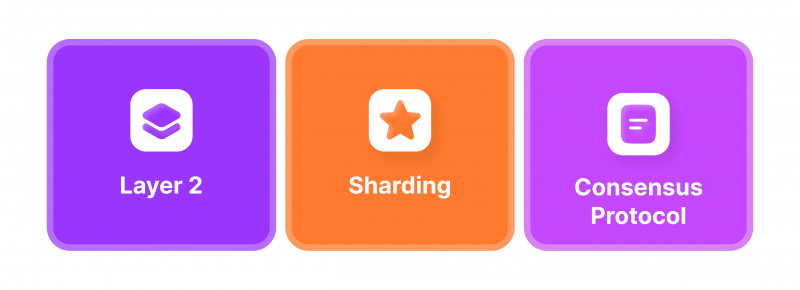
Ways To Solve The Blockchain Trilemma
There is no clear-cut solution to this problem. Otherwise, it would not be an issue now. However, there have been several attempts and updates to get the blockchain trilemma solved. We will go through some of these attempts and discuss their role in solving the trilemma.
Sharding
Sharding means breaking the blockchain into smaller chunks and letting each sub-blockchain manage the transactions and information separately. Eventually, each will be able to process transactions according to their ledger. These smaller blockchains, or Shards, are then connected through the mainnet.
This implementation takes the pressure off a single blockchain by breaking the information into smaller pieces assigned to each Shard, which works separately.
This solution helps scale the blockchain without risking its security because each Shard works independently. It can also make blockchain transactions faster because several mini-transactions are held simultaneously rather than having everything queued on the main blockchain.
Layer 2
Developers argue that adding a second layer to the main blockchain layer can ease the transaction process. Introducing a second layer built over the mainnet can help process information faster and more efficiently.
A layer-2 or a side chain is connected with the mainnet and allows information to move between two chains. The side chain operates with its own rules and is empowered to finalise transactions without showing them to the mainnet.
Then, smart contracts are used to allow interaction between users. This solution might look similar to sharding. However, Layer 2 focuses on adding a second network layer on the main blockchain, while sharding entails breaking the main blockchain into smaller pieces and changing the structure of the mainnet.
Consensus Protocol
Many blockchains are changing their traditional proof of work (PoW) validation protocol to proof of staking (PoS). PoS implies that validating nodes must stake their tokens before participating in the consensus mechanism.
Classically, PoW required powerful machines – or miners – to conduct complex algorithms and validate transactions. However, this process was time-consuming and required considerable energy.
Therefore, adding more nodes in the validation process is the better option, which guarantees the nodes to act in good faith since they are locking up and staking their tokens.
Discover the Tools That Power 500+ Brokerages
Explore our complete ecosystem — from liquidity to CRM to trading infrastructure.
Ongoing Efforts in Solving The Blockchain Trilemma
Some attempts have tackled this issue by introducing new updates to existing blockchains. The leading blockchain network, Ethereum, started taking serious steps to overcome the trilemma with the latest update to Serenity, or Ethereum 2.0.
Also, the new update includes shifting from the PoW mechanism to PoS, which promises to process 100,000 transactions per second. However, solving the trilemma this way will take time because it is a staged process.
Sharding was the main purpose of the new update: to split the blockchain into smaller pieces and improve scalability. However, later on, Ethereum announced that they dropped sharding from their timeline and would adopt a Layer 2 chain instead.
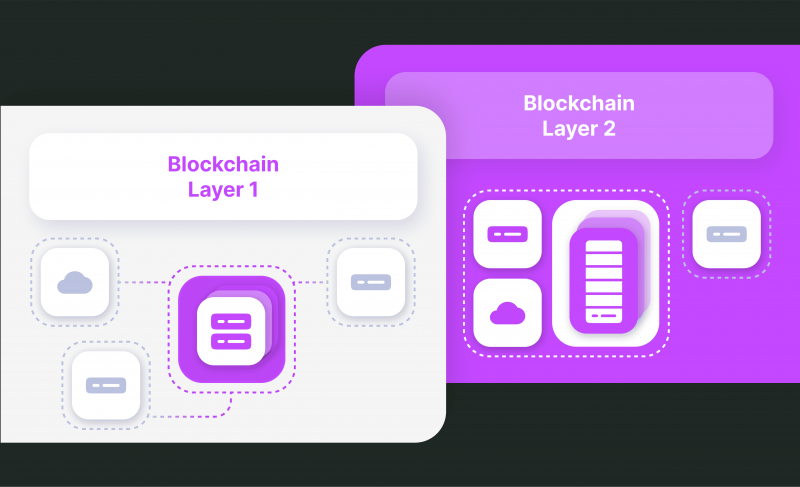
Why Do We Need To Solve The Blockchain Trilemma?
Blockchain technology has vast potential, and despite the developments found today, it is still in its preliminary stages. There is a whole array of functionalities that we theoretically know of but are yet to figure out how to get there.
Therefore, to reach there, we need to find solutions for the speed problems, making transactions faster, with minimum congestion times, and with low fees.
Yet, further developing the blockchain can expose it to unforeseeable security risks that we are unaware of. Therefore, developers are aware that strengthening the blockchain now is crucial to continue exploring the blockchain future.
Ultimately, the blockchain has been around for less than 20 years, and a huge potential needs to be explored. Once we solve this problem, we may find new levels of blockchain functionality that we have heard of.
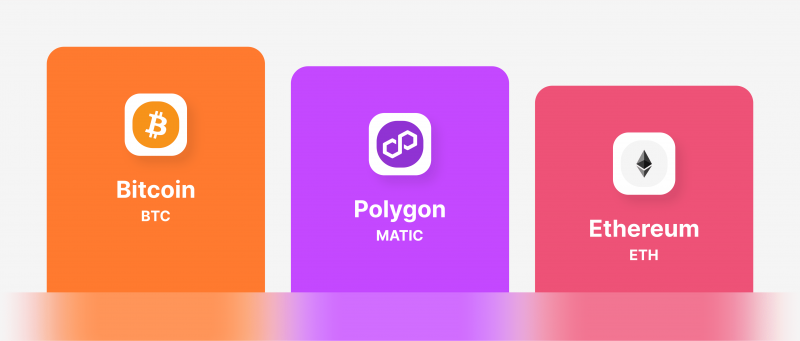
Final Remarks
The blockchain trilemma, including challenges in developing scalability, security, and decentralisation, makes developing blockchain challenging. These three elements are vital for the blockchain, but it seems that increasing one element could lead to compromising another. Efforts are ongoing to tackle this blockchain challenge and promote a faster and more secure blockchain. Ethereum 2.0 is one example of these approaches, which introduced sharding and layer-2 to make transactions seamless and secure, promising to process 100,000 TPS.
Finally, solving the trilemma will open new ways to benefit from this innovative technology, and we might only scratch the surface of the new level we might explore in future developments.
FAQ
What are the 3 points of the blockchain trilemma?
Decentralisation, security, and scalability are the main three pillars of the trilemma, which challenges developers to optimise all three elements at the same level without weakening any of them. Maintaining all of these elements is essential because they are fundamental concepts of the blockchain and the whole Web 3.0 space.
What does ETH 2.0 solve?
Ethereum 2.0 solves the transaction speed issues and the gas fees. While the ETH blockchain can process up to 30 transactions per second right now, it promises to reach 100,000 TPS with low congestion and low costs.
How do you solve the blockchain trilemma?
Developers have yet to find a golden strategy to solve the blockchain trilemma. However, there are ongoing efforts by developers to introduce new blockchain updates, such as sharding or adding a layer-2 network that increases the scalability without weakening security and decentralisation.







